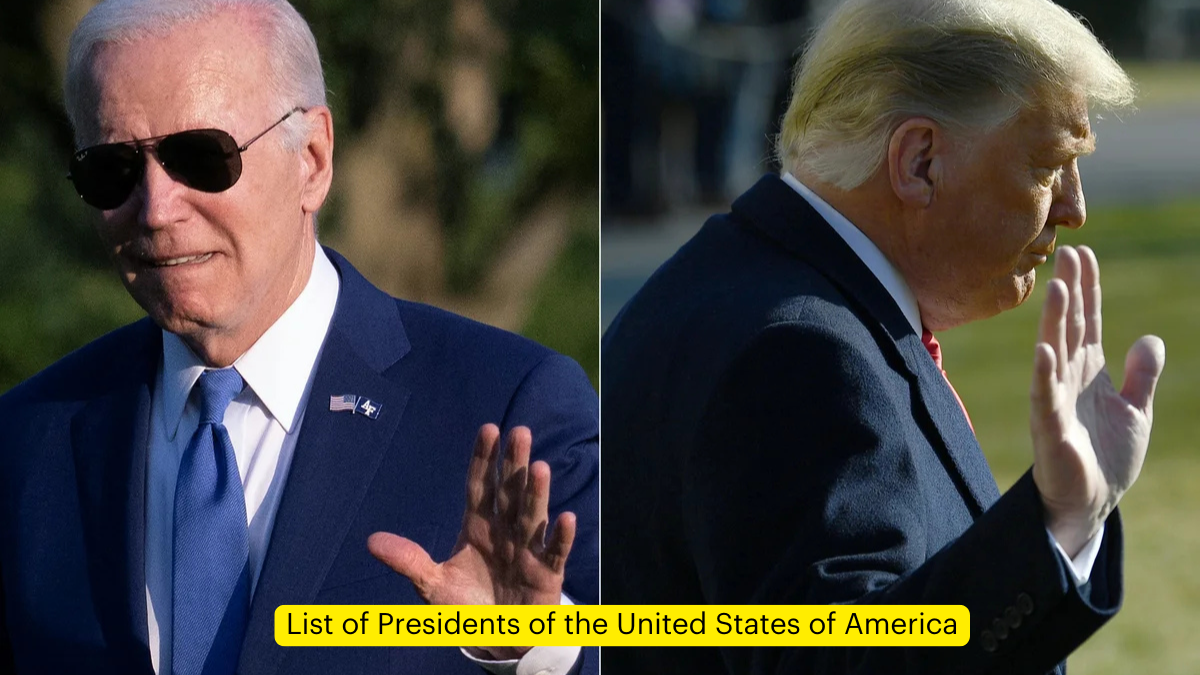The President of the United States is the head of state and government, overseeing the executive branch of the federal government and serving as the commander-in-chief of the United States Armed Forces. Since the office was established in 1789, 45 men have served in 46 presidencies. The officeholder is indirectly elected to a four-year term through the Electoral College, and the position is one of the most powerful in the world, influencing national and global policies. This article provides a detailed overview of the U.S. Presidency, its historical context, and a look at the individual presidents who have shaped the course of American history.
List of Presidents of the United States of America
| No. | Name | Birth–Death | Term | Party | Election | Vice President |
|---|---|---|---|---|---|---|
| 1 | George Washington | 1732–1799 | April 30, 1789 – March 4, 1797 | Unaffiliated | 1788–1789, 1792 | John Adams |
| 2 | John Adams | 1735–1826 | March 4, 1797 – March 4, 1801 | Federalist | 1796 | Thomas Jefferson |
| 3 | Thomas Jefferson | 1743–1826 | March 4, 1801 – March 4, 1809 | Democratic-Republican | 1800, 1804 | Aaron Burr, George Clinton |
| 4 | James Madison | 1751–1836 | March 4, 1809 – March 4, 1817 | Democratic-Republican | 1808, 1812 | George Clinton, Elbridge Gerry |
| 5 | James Monroe | 1758–1831 | March 4, 1817 – March 4, 1825 | Democratic-Republican | 1816, 1820 | Daniel D. Tompkins |
| 6 | John Quincy Adams | 1767–1848 | March 4, 1825 – March 4, 1829 | Democratic-Republican | 1824 | John C. Calhoun |
| 7 | Andrew Jackson | 1767–1845 | March 4, 1829 – March 4, 1837 | Democratic | 1828, 1832 | John C. Calhoun, Martin Van Buren |
| 8 | Martin Van Buren | 1782–1862 | March 4, 1837 – March 4, 1841 | Democratic | 1836 | Richard Mentor Johnson |
| 9 | William Henry Harrison | 1773–1841 | March 4, 1841 – April 4, 1841 | Whig | 1840 | John Tyler |
| 10 | John Tyler | 1790–1862 | April 4, 1841 – March 4, 1845 | Whig, Unaffiliated | – | Vacant |
| 11 | James K. Polk | 1795–1849 | March 4, 1845 – March 4, 1849 | Democratic | 1844 | George M. Dallas |
| 12 | Zachary Taylor | 1784–1850 | March 4, 1849 – July 9, 1850 | Whig | 1848 | Millard Fillmore |
| 13 | Millard Fillmore | 1800–1874 | July 9, 1850 – March 4, 1853 | Whig | – | Vacant |
| 14 | Franklin Pierce | 1804–1869 | March 4, 1853 – March 4, 1857 | Democratic | 1852 | William R. King |
| 15 | James Buchanan | 1791–1868 | March 4, 1857 – March 4, 1861 | Democratic | 1856 | John C. Breckinridge |
| 16 | Abraham Lincoln | 1809–1865 | March 4, 1861 – April 15, 1865 | Republican, National Union | 1860, 1864 | Hannibal Hamlin, Andrew Johnson |
| 17 | Andrew Johnson | 1808–1875 | April 15, 1865 – March 4, 1869 | National Union, Democratic | – | Vacant |
| 18 | Ulysses S. Grant | 1822–1885 | March 4, 1869 – March 4, 1877 | Republican | 1868, 1872 | Schuyler Colfax, Henry Wilson |
| 19 | Rutherford B. Hayes | 1822–1893 | March 4, 1877 – March 4, 1881 | Republican | 1876 | William A. Wheeler |
| 20 | James A. Garfield | 1831–1881 | March 4, 1881 – September 19, 1881 | Republican | 1880 | Chester A. Arthur |
| 21 | Chester A. Arthur | 1829–1886 | September 19, 1881 – March 4, 1885 | Republican | – | Vacant |
| 22 | Grover Cleveland | 1837–1908 | March 4, 1885 – March 4, 1889 | Democratic | 1884 | Thomas A. Hendricks |
| 23 | Benjamin Harrison | 1833–1901 | March 4, 1889 – March 4, 1893 | Republican | 1888 | Levi P. Morton |
| 24 | Grover Cleveland | 1837–1908 | March 4, 1893 – March 4, 1897 | Democratic | 1892 | Adlai Stevenson I |
| 25 | William McKinley | 1843–1901 | March 4, 1897 – September 14, 1901 | Republican | 1896, 1900 | Garret Hobart, Theodore Roosevelt |
| 26 | Theodore Roosevelt | 1858–1919 | September 14, 1901 – March 4, 1909 | Republican | – | Charles W. Fairbanks |
| 27 | William Howard Taft | 1857–1930 | March 4, 1909 – March 4, 1913 | Republican | 1908 | James S. Sherman |
| 28 | Woodrow Wilson | 1856–1924 | March 4, 1913 – March 4, 1921 | Democratic | 1912, 1916 | Thomas R. Marshall |
| 29 | Warren G. Harding | 1865–1923 | March 4, 1921 – August 2, 1923 | Republican | 1920 | Calvin Coolidge |
| 30 | Calvin Coolidge | 1872–1933 | August 2, 1923 – March 4, 1929 | Republican | – | Vacant |
| 31 | Herbert Hoover | 1874–1964 | March 4, 1929 – March 4, 1933 | Republican | 1928 | Charles Curtis |
| 32 | Franklin D. Roosevelt | 1882–1945 | March 4, 1933 – April 12, 1945 | Democratic | 1932, 1936, 1940, 1944 | John Nance Garner, Henry A. Wallace, Harry S. Truman |
| 33 | Harry S. Truman | 1884–1972 | April 12, 1945 – January 20, 1953 | Democratic | – | Alben W. Barkley |
| 34 | Dwight D. Eisenhower | 1890–1969 | January 20, 1953 – January 20, 1961 | Republican | 1952, 1956 | Richard Nixon |
| 35 | John F. Kennedy | 1917–1963 | January 20, 1961 – November 22, 1963 | Democratic | 1960 | Lyndon B. Johnson |
| 36 | Lyndon B. Johnson | 1908–1973 | November 22, 1963 – January 20, 1969 | Democratic | – | Hubert Humphrey |
| 37 | Richard Nixon | 1913–1994 | January 20, 1969 – August 9, 1974 | Republican | 1968, 1972 | Spiro Agnew, Gerald Ford |
| 38 | Gerald Ford | 1913–2006 | August 9, 1974 – January 20, 1977 | Republican | – | Nelson Rockefeller |
| 39 | Jimmy Carter | 1924– | January 20, 1977 – January 20, 1981 | Democratic | 1976 | Walter Mondale |
| 40 | Ronald Reagan | 1911–2004 | January 20, 1981 – January 20, 1989 | Republican | 1980, 1984 | George H. W. Bush |
| 41 | George H. W. Bush | 1924–2018 | January 20, 1989 – January 20, 1993 | Republican | 1988 | Dan Quayle |
| 42 | Bill Clinton | 1946– | January 20, 1993 – January 20, 2001 | Democratic | 1992, 1996 | Al Gore |
| 43 | George W. Bush | 1946– | January 20, 2001 – January 20, 2009 | Republican | 2000, 2004 | Dick Cheney |
| 44 | Barack Obama | 1961– | January 20, 2009 – January 20, 2017 | Democratic | 2008, 2012 | Joe Biden |
| 45 | Donald Trump | 1946– | January 20, 2017 – January 20, 2021 | Republican | 2016 | Mike Pence |
| 46 | Joe Biden | 1942– | January 20, 2021 – Present | Democratic | 2020 | Kamala Harris |
| 47 | Donald Trump | 1946– | 11 November-Present | Republican | 2024 | – |
The Office of the U.S. President: An Overview
The presidency was created by the Constitution of the United States and has evolved significantly over the centuries. The president leads the executive branch, ensuring the enforcement of federal laws, managing national affairs, and representing the U.S. in diplomatic matters.
The Role and Powers of the President
As head of state and government, the U.S. president wields substantial power, which includes:
- Commander-in-chief of the armed forces
- Overseeing the executive branch of the government
- The ability to sign or veto legislation passed by Congress
- Appointing federal judges, including Supreme Court justices
- Conducting diplomacy with foreign governments
The presidency has changed and adapted to meet the needs of the times, with significant historical moments affecting the role, such as the Twenty-second Amendment, which limits presidents to two terms, and the Twenty-fifth Amendment, which clarifies the line of succession in case of death, resignation, or incapacity.




 Which Country is Known as the Land of Ch...
Which Country is Known as the Land of Ch...
 Which Bird is known as the King of Birds...
Which Bird is known as the King of Birds...
 Which City of Austria is Known as the Ci...
Which City of Austria is Known as the Ci...







